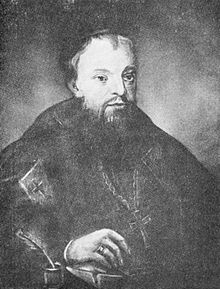Rafajil Korsak
Rafal Korsak (Raphael Korsak) | |
|---|---|
| Metropolitan of Kiev | |
 | |
| Church | Ruthenian Uniate Church |
| Appointed | 5 February 1637 |
| Term ended | 28 August 1640 |
| Predecessor | Joseph Velamin-Rutski |
| Successor | Anthony Sielava |
| Orders | |
| Consecration | Sept 1626 (Bishop) |
| Personal details | |
| Born | between 1598 and 1601 near Navahrudak |
| Died | 28 August 1640 Rome |
Rafajil Nikolai Korsak (Belarusian: Рафал Мікалай Корсак, Ukrainian: Рафаїл Корсак, Polish: Rafał Mikołaj Korsak) (c. 1599 – 28 August 1640) was the Metropolitan of Kiev, Galicia and Russia of the Ruthenian Uniate Church from 1637 to his death in 1640.
Life[]
Mikalai Korsak was born near Navahrudak from a noble Calvinist family.[1] Primaries sources disagree on his birth year, which anyway can be fixed into a range from 1598 to 1601.[2] He studied by the Jesuits in Niasviž and in Vilnius, and later in Papal Missionary College in Braniewo and by the Jesuits in Prague. By the Jesuits he converted to the Latin Church and later, supported by Metropolitan Jazep Velamin-Rutski, he joined the Greek-Catholic Church. In 1620 he entered in the Order of Saint Basil the Great taking the religious name of Rafajil (Rafael) and he passed his year of novitiate in the monastery of Byten.[3][2] He studied in the Greek College in Rome from December 1621 to November 1624,[4] when he was requested to return in his country to serve as a bishop.
In 1625 Korsak became archimandrite of the monastery of the Holy Trinity in Vilnius (the main monastery of the Order), in 1626 Proto-Archimandrite (i.e. Superior general) of the whole order (an office he kept till 1636) and in September 1626 he was consecrated a bishop with the title of Galicia. Metropolitan Rutsky chose him as coadjutor bishop with right of succession, and so he was confirmed by Rome on 9 March 1631 notwithstanding the initial concern of the King for his young age. In 1632 he became Eparch (bishop) of Pinsk.[5]
In 1632 the situation of the Greek-Catholic Church had a downturn because of the death of the King Sigismund III who had supported the Church since the Union of Brest. The new king, Władysław IV, to be elected signed the "Pacta Conventa" which were favorable to the Orthodox faction, supported by the Cossacks, and prejudicial to the Greek-Catholic Church.[6] Korsak was sent to Rome to find support for the position of his Church, as he succeeded to do. He remained in Rome from 1633 to 1635.[2]
Metropolitan Rutsky died on 5 February 1637 and Korsak became the new Metropolitan of Kiev and head of the Greek-Catholic Church.[7] As his predecessor, he went on in negotiations with the Orthodox Metropolitan of Kiev, Peter Mogila about the way to unify the Ukrainian Church,[6] but in 1639 he had to return to Rome for the third time, requested to visit the pope (visit ad Limina). He arrived in Rome in September 1639, and he passed the winter there. In 1640 he fell ill, and he died in Rome on 28 August 1640. He was buried in the Greek Rite church of Santi Sergio e Bacco.[2]
He wrote a biography of Metropolitan Rutsky, and he translated in Latin the works of Meletius Smotrytsky.[1]
References[]
The Golden Horde: The Encyclopedia. The 3 tons / red. GP Pasha and others. Volume 2: Cadet Corps - Jackiewicz. - Minsk: Belarusian Encyclopedia, 2005. - 788 s.: Il. ISBN 985-11-0378-0.
Encyclopedia. At 6 vols 4: The Cadets - Leschenya / Belarusian. Encyclopedia.; Editorial Board.: GP PASHKOV (Chief Ed.) And others.; Sett. EE Zhakevich. - Mn.: BelEn, 1997. - 432 p.: Il. ISBN 985-11-0041-2.
Entsiklopediya istoriї of Ukraine: V. 5: Con - Kyu / Editorial Board.: VA Smolichi (head) that in. National Academy of Sciences of Ukraine. Istoriї Institute of Ukraine. - K.: B-"Naukova Dumka", 2008. - 568 p.
Nazarko I. Metropolitans of Kiev and Galician: Biographical Sketches (1590-1960) . - Rome, 1962.
On Sat Praha-Vilnius, 1981: Florovský Antonín V., Čeští jezuité na Rusi. Jezuitské provincie a slovanský východ, Prague, Vyšehrad 1941.
Poor SN Papacy and Ukraine. Politics Rymskoy chickens at Ukrainian lands in XVI-XVII centuries. K., 1989.
Wise S. Essay on the History of the Church in Ukraine. Ivano-Frankivsk, 1999.
Sapelyak A. Kiev church in Slavic East. Canonico-ecumenical aspect. Buenos Aires, Lviv, 1999.
Notes[]
- ^ Jump up to: a b Н.С. Рубльова. "КОРСАК Рафаїл". Інститут історії України Національної академії наук України. Retrieved 27 May 2011.
- ^ Jump up to: a b c d Welykyv, Athanasius (1956). "Raphaelis Korsak Biographia". Epistolae metropolitarum Kioviensium catholicorum Raphaels Korsak, Antonii Sielava, Gabrielis Kolenda. Analecta OSBM. Serie 2. Sectio 3. Rome. pp. 4–8.
- ^ Belarusian: Быцень Быцень, in Ivatsevichy Raion
- ^ Blazejowsky, Dmytro (1979). "Ukrainian and Bielorussian students at the Pontifical Greek College of Rome". Analecta Ordinis S. Basilii Magni. Rome: sumptibus PP. Basilianorum (Sectio II, vol X (XVI), Fasc 1-4): 152.
- ^ Blazejowsky, Dmytro (1990). Hierarchy of the Kyivan Church (861-1990). Rome. pp. 250, 268.
- ^ Jump up to: a b Baran, Alexander (1971). "Propaganda's concern for the Church in Ukraine and Bielorussia". In Metzler J. (ed.). Sacrae Congregationis de Propaganda Fide Memoria Rerum. I/2. Herder. pp. 228–232.
- ^ Patritium Gauchat (1935). Hierarchia catholica Medii aevi sive summorum pontificum, S.R.E. cardinalium, ecclesiarum antistitum series. 4. Regensburg. p. 150. Missing or empty
|title=(help)
External links[]
- 1640 deaths
- People from Nowogródek Voivodeship (1507–1795)
- Ruthenian nobility of the Polish–Lithuanian Commonwealth
- Converts to Eastern Catholicism from Calvinism
- Order of Saint Basil the Great
- Leaders of the Ruthenian Uniate Church
- Archimandrites